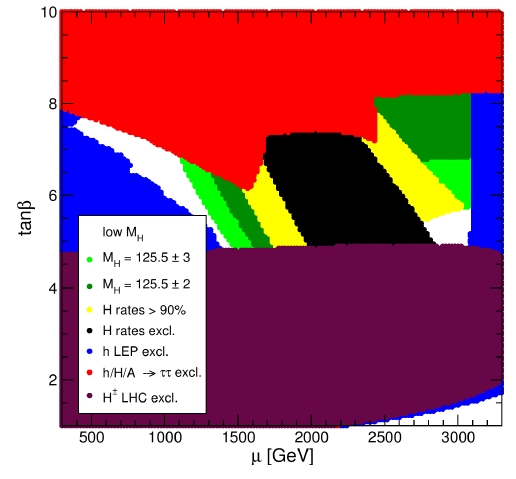Last week a new important paper appeared in the Arxiv: "MSSM Higgs Boson Searches at the LHC:Benchmark Scenarios after the Discovery of a Higgs-like Particle", by M.Carena, S.Heinemeyer, O. Stal, C.Wagner, and G.Weiglein. The paper fills a void that was created after the discovery of the Higgs particle last July by the ATLAS and CMS experiments: a thorough assessment of what constraints on the allowed chunks of SUSY parameter space in the light of the existence of a neutral scalar at 125 GeV.
The issue is complicated, because Supersymmetry is not just a theory, but a framework within which one can build quite different phenomenologies, depending on the exact value of a multitude of free parameters. So hard is the problem of characterizing this wide 100+-dimensional space that before one ventures to study the model predictions one must decide on a set of "test points" which can be used as benchmarks. These are called "benchmark scenarios", and agreeing on the particular values of the defining parameters is important for a number of reasons: understanding how strong are the experimental constraints of subsequent experiments, comparing the sensitivity of different searches, and figuring out what may be the most distinctive signatures of the considered models.
Hence the study, which is quite extensive and covers several possibilities for some of the experimental signatures of the Higgs sector of the MSSM (the minimal Supersymmetric extension of the standard model, already a restrictive choice in the mare magnum of possibilities) which can be nailed early on by LHC measurements: for example, rates of specific decays of the Higgs-like particle discovered last July. The study also considers the possibility that the particle is not the lightest neutral scalar, but actually the heavy one; such hypothesis creates of course wholly different scenarios.
One bit of the discussion on which I am personally interested (although, as you might recall, I remain a strong SUSY sceptic) is the scenario where the discovered light Higgs boson can be produced in pairs by the decay of a heavier counterpart: H->hh. Such a circumstance is possible in a wide chunk of parameter space and would lead to quite interesting experimental signatures. Given that I was involved in the search for the MSSM bbH->bbbb production process, which resulted in a recent publication (cited by the article discussed here), it is clear that the option of studying the H->hh->bbbb process in the same final state (one involving four b-flavoured jets) is quite attractive. We'll see what we end up doing there...
Anyway, this article is titled "the plot of the week", so let me pick a representative graph from the paper to stimulate you to give a deeper look. The graph is a representation of the plane of two of the parameters defining the MSSM: tan(β) and μ in the so-called "low-mH scenario". Different coloured swaths of the plane correspond to areas that experimental searches have already excluded (such as the purple one at the bottom, which is excluded by direct LHC searches for MSSM particles, or the blue one excluded by LEP experiments, or the red one excluded by limits on the H->ττ decay by ATLAS and CMS; the most interesting regions are those in green, which correspond to values of the Higgs boson measured by the experiments. The black area instead correspond to parameter space points which would predict rates of Higgs production too high with respect to what has been observed.

All in all one gets the impression that the "window of opportunity" for the MSSM is closing down. But if you read the paper (written by MSSM enthusiasts) you might get a different idea !


